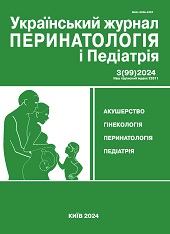Personal experience of simultaneous surgical treatment of patients with deep infiltrative endometriosis affecting the rectosigmoid sections of the large intestine
DOI:
https://doi.org/10.15574/PP.2024.3(99).7478Keywords:
deep infiltrative endometriosis, laparoscopy, simultaneous surgery, minimally invasive surgeryAbstract
Endometriosis affects approximately 10% of women globally and can lead to infertility (30-50% of cases) and a significant decline in quality of life. One of the most severe forms of this disease is deep infiltrative endometriosis (DIE).
Аim - to evaluate the effectiveness of multidisciplinary surgical treatment for patients with DIE in the short term.
Materials and methods. The study included 18 patients with confirmed DIE and bowel involvement, treated. Laparoscopic surgical interventions were performed following Enhanced Recovery After Surgery principles. The parameters assessed included the duration of surgery, pain level, length of hospital stay, and early postoperative complications.
Results. The average duration of surgery was 145.83±15.3 minutes. Bowel involvement was localized to the anterior surface of the rectum in 7 cases and the rectosigmoid area in 4 cases. The average size of endometriotic lesions was 3.83±0.75 cm. All resections were performed with R0 margins, and no protective stoma was placed. Early postoperative complications included transient nausea and vomiting in 6 patients, managed conservatively. Pain levels, measured by the ACCS scale, were 57.51±10.51 points at 12 hours post-operation and 19.7±8.51 points after 24 hours. The average hospital stay was 3.66±0.81 days. After 3 months, 6 patients reported complete symptom relief, 6 noted significant symptom reduction, and 12 experienced improved quality of life.
Conclusions. Multidisciplinary laparoscopic surgical treatment of deep infiltrative endometriosis with bowel involvement is safe and effective in the short term. Patients show significant improvement in quality of life and reduction in pain. However, long-term evaluation of the condition is necessary.
The research was carried out in accordance with the principles of the Helsinki Declaration. The study protocol was approved by the Local Ethics Committee of participating institution. The informed consent of the patient was obtained for conducting the studies.
No conflict of interest was declared by the authors.
References
De Cassai A, Boscolo A, Tonetti T, Ban I, Ori C. (2019). Assignment of ASA-physical status relates to anesthesiologists' experience: a survey-based national-study. Korean J Anesthesiol. 72(1): 53-59. https://doi.org/10.4097/kja.d.18.00224; PMid:30424587 PMCid:PMC6369346
De Lange JS, Jacobs J, Meiring N, Moroane B, Verster T, Olorunju S, Mashola MK. (2020). Reliability and validity of the Readiness for Hospital Discharge Scale in patients with spinal cord injury. S Afr J Physiother. 76(1): 1400. https://doi.org/10.4102/sajp.v76i1.1400; PMid:32537524 PMCid:PMC7276478
Dunselman GAJ, Vermeulen N, Becker C, Calhaz-Jorge C, D'Hooghe T, De Bie B et al. (2014). ESHRE guideline: management of women with endometriosis. Hum Reprod. 29(3): 400-412. https://doi.org/10.1093/humrep/det457; PMid:24435778
Grossi E, Borghi C, Cerchiari EL, Della Puppa T, Francucci B. (1983). Analogue chromatic continuous scale (ACCS): a new method for pain assessment. Clin Exp Rheumatol. 1(4): 337-340.
Habib N, Centini G, Lazzeri L, Amoruso N, El Khoury L, Zupi E, Afors K. (2020). Bowel Endometriosis: Current Perspectives on Diagnosis and Treatment. Int J Womens Health. 12: 35-47. https://doi.org/10.2147/IJWH.S190326; PMid:32099483 PMCid:PMC6996110
Koninckx PR, Meuleman C, Oosterlynck D, Cornillie FJ. (1996). Diagnosis of deep endometriosis by clinical examination during menstruation and plasma CA-125 concentration. Fertil Steril. 65(2): 280-287. https://doi.org/10.1016/S0015-0282(16)58086-8; PMid:8566249
Missmer SA, Hankinson SE, Spiegelman D, Barbieri RL, Marshall LM, Hunter DJ. (2004). Incidence of laparoscopically confirmed endometriosis by demographic, anthropometric, and lifestyle factors. Am J Epidemiol. 160: 784-796. https://doi.org/10.1093/aje/kwh275; PMid:15466501
Nelson G, Bakkum-Gamez J, Kalogera E, Glaser G, Altman A, Meyer LA et al. (2019). Guidelines for perioperative care in gynecologic/oncology: Enhanced Recovery After Surgery (ERAS) Society recommendations - 2019 update. Int J Gynecol Cancer. 29(4): 651-668. https://doi.org/10.1136/ijgc-2019-000356; PMid:30877144
Nisolle M, Donnez J. (1997). Peritoneal endometriosis, ovarian endometriosis, and adenomyotic nodules of the rectovaginal septum are three different entities. Fertil Steril. 68(4): 585-596. https://doi.org/10.1016/S0015-0282(97)00191-X; PMid:9341595
Scott MJ, Scott MJ, Baldini G, Fearon KC, Feldheiser A, Feldman LS et al. (2015). Enhanced Recovery After Surgery (ERAS) for gastrointestinal surgery, part 1: pathophysiological considerations. Acta Anaesthesiol Scand. 59(10): 1212-1231. https://doi.org/10.1111/aas.12601; PMid:26346577 PMCid:PMC5049676
Shafrir AL, Farland LV, Shah DK, Harris HR, Kvaskoff M, Zondervan K, Missmer SA. (2018). Risk for and consequences of endometriosis: A critical epidemiologic review. Best Pract Res Clin Obstet Gynaecol. 51: 1-15. Epub 2018 Jul 3. https://doi.org/10.1016/j.bpobgyn.2018.06.001; PMid:30017581
Simoens S, Dunselman G, Dirksen C, Hummelshoj L, Bokor A, Brandes I et al. (2012). The burden of endometriosis: costs and quality of life of women with endometriosis and treated in referral centres. Hum Reprod. 27(5): 1292-1299. https://doi.org/10.1093/humrep/des073; PMid:22422778
Veeraswamy A, Lewis M, Mann A, Kotikela S, Hajhosseini B, Nezhat C. (2010). Extragenital endometriosis. Clin Obstet Gynecol. 53(2): 449-466. https://doi.org/10.1097/GRF.0b013e3181e0ea6e; PMid:20436322
Downloads
Published
Issue
Section
License
Copyright (c) 2024 Ukrainian Journal of Perinatology and Pediatrics

This work is licensed under a Creative Commons Attribution-NonCommercial 4.0 International License.
The policy of the Journal “Ukrainian Journal of Perinatology and Pediatrics” is compatible with the vast majority of funders' of open access and self-archiving policies. The journal provides immediate open access route being convinced that everyone – not only scientists - can benefit from research results, and publishes articles exclusively under open access distribution, with a Creative Commons Attribution-Noncommercial 4.0 international license(СС BY-NC).
Authors transfer the copyright to the Journal “MODERN PEDIATRICS. UKRAINE” when the manuscript is accepted for publication. Authors declare that this manuscript has not been published nor is under simultaneous consideration for publication elsewhere. After publication, the articles become freely available on-line to the public.
Readers have the right to use, distribute, and reproduce articles in any medium, provided the articles and the journal are properly cited.
The use of published materials for commercial purposes is strongly prohibited.

